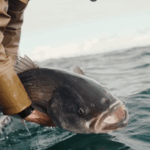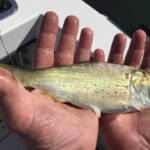
Release Mortality Revisited: New Research from Massachusetts DMF
Feature Photo Credit: Robbie Tartaglia What’s going on? For decades, striped bass management relied on a
Last week, the Atlantic States Marine Fisheries Commission (ASMFC) met in New Jersey for its Annual Meeting. The agenda items we were keeping the closest eye on were striped bass, menhaden, and some other perimeter issues. A common theme emerged in both the Striped Bass and Menhaden Board meetings: In the face of uncertainties, precautionary management is not getting enough support.
Striped Bass Management Board
This meeting was obviously our number one priority, as rebuilding the striped bass stock and managing it for abundance and a quality angler experience are huge for us at ASGA. There were two big agenda items for the Striped Bass Board: 1) Reviewing and approving the 2022 Striped Bass Stock Assessment Update (and determining if reductions would be needed to successfully rebuild by 2029); and 2) considering approving Draft Addendum 1 (allowing voluntary commercial quota transfers between states) for public comment.
If you read these blogs, you know that we asked for a last-second push to remove any Conservation Equivalency programs from striped bass management. In a technicality, CE was allowed to persist in its existing form for 2023 because the stock assessment did not require any further reductions or management changes. Our effort to reverse that failed. We gave it our best and thank everyone who sent emails in. While certain states can continue to use their shaky CE plans, our message clearly resonated with several commissioners who did what they could to ensure the stock rebuilds.
No need to go into too much detail on the 2022 assessment update—click here for our more in-depth review. In summary, however, the assessment found that the stock is no longer undergoing overfishing, but remains overfished; and while it is projected to rebuild by 2029, we also have some concerns. We continue to be concerned and skeptical about whether we will be able to maintain the current low fishing mortality rate (F, the rate at which we are killing fish) in order to successfully rebuild. Some Board members shared these concerns—notably, Mike Armstrong from the Massachusetts Division of Marine Fisheries, and NY Board Member Emerson Hasbrouck from the Cornell Cooperative Extension.
Armstrong offered a different perspective; he shared some sage words of caution. The gist of his comment centered around how striped bass are the most important fish on the Atlantic coast and, considering the awful recruitment realities in recent years and how difficult it is to effectively control F, the Board needs to be very, very careful moving forward and with rebuilding.
Hasbrouck and some other Commissioners shared similar thoughts. For example, we heard his comment that striped bass management is on a “razor’s edge” with fishing mortality, which can easily throw rebuilding projections awry. He then went on to request some sort of “interim analysis” to ensure that management keeps a close eye on striped bass and is able to react if catches and fishing mortality show unexpected jumps.
That was one of the saving graces from the meeting and a direct result of your emails: Next spring, the Striped Bass Management Board will take a look at finalized 2022 catch estimates and compare those estimates to what was determined to be within an acceptable range—and, importantly, the Board will react with an addendum if management needs to be tweaked in order to remain on track for rebuilding.
Sure, we would have preferred if the Board had initiated a precautionary management change at this meeting, to account for an anticipated increase in catch and effort (because of the 2015 year class entering the slot) and to build in some cushion for when the last four terribly low year classes start to contribute to the coastal stock. But, that did not happen, so we’ll just have to continue to monitor striped bass and hope that the few remaining strong year classes do not get wiped out.
The next striper issue was Draft Addendum 1, to allow commercial quota transfers. We will be engaging on this issue and strongly oppose it. ASGA has never been an anti-commercial group, and we know as well as anyone that the commercial sector accounted for only 13% of striped bass removals while we, the recreational sector, were responsible for 87%. However, rebuilding the stock will take all of us, and an addendum to increase commercial harvests is utterly antithetical to that goal. You see, the stock assessment scientists and managers have come to rely on the commercial sector’s underutilization, so maxing out the quota could have some unintended impacts. The Board approved sending Addendum 1 out for public comment.
How does ASMFC expect the public to look at this; The Board had no appetite to initiate an addendum to get rid of the previously approved CE plans or inject some more caution into the rebuilding plan, but they are okay changing the Striped Bass Fishery Management Plan to allow states to transfer quota amongst each other? To us this is tone-deaf, shows the Commission’s faults, and just opens an entire can of worms, which will not help to efficiently rebuild the stock.
Menhaden
The two issues for the Menhaden Management Board were specifying the 2023-2025 Total Allowable Catch (TAC) and considering Addendum 1 to Amendment 3, which would revise, among other things, commercial allocations. Menhaden are a hot commodity right now due to poor abundance of other forage species and the needs of the bait industry.
The Board first took up the specifications issue. Immediately some alarm bells went off. Based on the stock assessment and Ecological Reference Points modeling (which accounts for the species’ critical role as forage), the Board was presented with various TACs with different probabilities of exceeding those ERPs. At a 50% probability, the Board could have approved a 318,600 metric ton TAC for 2023, compared to the 2022 TAC of 194,400 metric tons. Quite the increase. These ERP calculations are tricky, they rely on numerous other factors such as striped bass abundance and other forage species. The idea is to set a TAC that leaves enough menhaden in the water for various predators.

Well, the model kicked out TACs with some very substantial increases, at the same time that striped bass SSB is increasing, other forage species aren’t as abundant, and the terminal years of the menhaden stock assessment rely on the notoriously concerning 2020 and 2021 data years. All of this is to say that while there was a good bit of uncertainty, there was also a basis to maybe liberalize in a calculated, responsible manner.
That is why we were supportive of a motion by Allison Colden and Rob LaFrance to increase the TAC by 10% this go-around. From our perspective this would have captured the concerns about these new TACs, and the need to keep menhaden in the water for predators, while also allowing states access to the increasingly abundant menhaden. That idea would have been the precautionary and responsible way forward, especially amid these uncertainties and unprecedented high catch limits.
Needless to say, that motion was not approved by the Board—it seems the demand for menhaden is just too high.
The Board eventually approved a compromise approach, of sorts. The Board unanimously approved Megan Ware’s (Maine) motion to set the 2023-2025 TAC at 233,550 mt. While this TAC is still a huge increase—39,150mt or more than 85 million pounds of menhaden—it was far less than what the TC determined would have been scientifically acceptable. Are we thrilled that 233,550 mt of menhaden will be likely caught each of the next three years? No, but it is better than larger TACs that would have been defensible from a science perspective. Are we going against science? No, we are incredibly hesitant to approve an unprecedented increase in the TAC for the most important forage fish in the ocean with some shaky data years and would have preferred to see a more gradual increase in the TAC. We are also not thrilled that, based on these allocations, the vast majority of this TAC increase will again go to Virginia and by default, Omega Protein. Fortunately, VA and Omega will still be held to the Chesapeake Bay catch cap. But still, the final outcome is better than what could have happened.


New allocation % vs. the previous allocations.
Then the Board took up the Allocation Addendum. For the most part, the decision points for the Addendum are complex and technical modifications, so we’ll hit the key outcomes. The new allocations are based on a three-tiered system using catch data from 2018, 2019, and 2021 and northern states received a much-needed bump in their allocation—on top of the bump in TAC they also just received not 30 minutes earlier. In addition, the Board made some improvements to the incidental catch/small-scale fisheries provisions, mainly requiring that catch under those authorities be accounted for and be counted against the total TAC. You can learn more about the other provisions of the new approved Addendum here.
All in all, this meeting could have gone a lot worse. Sure, we wish some of these decisions went differently and that the Board would prioritize precautionary management more often. Both of these decisions have some key uncertainties. And well nearly every decision in fisheries management will carry with it some uncertainty, we need to be better about quantifying uncertainties—and then rely on precautionary management principles amid these uncertainties.

Feature Photo Credit: Robbie Tartaglia What’s going on? For decades, striped bass management relied on a

Recent developments in the 2025 Atlantic Menhaden Stock Assessment Update, released by the Atlantic States

What’s going on? The “most important fish in the sea” just exposed one of the

Mario CampoFisheries Ecologist, Southeastern Louisiana UniversityScience and Policy Associate, American Saltwater Guides Association This discussion
We rely on our members and donations to keep fighting for a sustainable tomorrow in marine conservation.
GIVE THE GIFT OF FISHERIES CONSERVATION THIS HOLIDAY SEASON. SHOP ASGA GOODS THAT FUND FISHERIES RESEARCH & ADVOCACY CAMPAIGNS
JOIN ASGA IN CALLING FOR CRITICAL MANAGEMENT ACTION AFTER YEARS OF SPAWN FAILURES & POOR MANAGEMENT.
By using this website, you agree to our use of cookies. We use cookies to provide you with a great experience and to help our website run effectively. To learn more, please review our privacy policy.